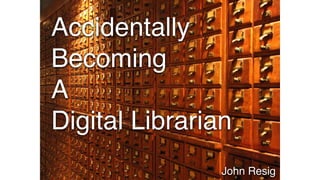
Accidentally Becoming a Digital Librarian
- 2. Providing Access to Knowledge. Educating and Empowering Others.
- 3. 1. Solve your own problems
- 4. 2. Adapt and solve other’s problems
- 5. Talking about 4 problems
- 7. Problem 1: Searching by Image
- 12. imgSeek • Compares entire image. • Finds similar images, not exact. • Does not find parts of an image. • Color sensitive. • Open Source
- 17. Problem 2: No one agrees on names/titles
- 18. Japanese Names • Utagawa Hiroshige • Ando Hiroshige • Andō Hiroshige • Hiroshige • 歌川広重 • 広重
- 25. Similar Images Different photo, same work of art.
- 26. Similar Images Different photo, slightly different cropping.
- 27. Alternate Images Partial Image vs. Much Larger Image
- 28. Alternate Images Color vs. Black-and-White
- 29. Conservation
- 30. Conservation Repairs and possibly removal of later additions.
- 31. Conservation/Destruction Analysis even spots dramatic conservation work.
- 32. Copies
- 33. Copies
- 34. Copies
- 35. Copies
- 37. Fondazione Zeri
- 38. PHAROS: An International Consortium of Photo Archives • Bibliotheca Hertziana, Rome (1,065,000) • Bildarchiv Foto Marburg, Germany (2,000,000) • Courtauld Institute of Art, London (4,173,500) • Fondazione Federico Zeri, Bologna (290,000) • Frick Art Reference Library, New York (1,346,000) • Getty Research Institute, Los Angeles (2,086,000) • Villa I Tatti, Florence (239,000) • Institut National d’Histoire de l’Art, Paris (750,000) • Kunsthistorisches Institut, Florence (650,000) • National Gallery of Art, Washington (7,600,000) • Paul Mellon Centre, London (185,000) • Rijksbureau, The Hague (7,000,000 • Warburg Institute, London (3,500,000) • Yale Center for British Art, New Haven (132,000)
- 40. PHAROS Images: Coming June 2016
- 41. Problem 3: Bad Images
- 44. Idyll: Offline Image Cropping • Crop and annotate images offline and on a mobile device. • Saves the selections back to a server.
- 48. ComputerVision • Unsupervised (requires no labeling): • Comparing an entire image • Categorizing an image • Supervised (requires labeling): • Finding parts of an image • Finding and categorizing parts of an image
- 49. Unsupervised Training • Requires little-to-no prepping of data • Can just give the tool a set of images and have it produce results • Extremely easy to get started, results aren’t always as interesting. • Unsupervised: MatchEngine, PasteC
- 50. Supervised Training • Need lots of training data • Needs to be pre-selected/categorized • Think:Thousands of images. • If your collection is smaller than this, perhaps it may not benefit. • Or you may need crowd sourcing. • Results can be more interesting: • “Find all the people in this image”
- 51. General Computer Vision • Ideal for some supervised training problems • CCV • http://libccv.org/ • https://github.com/liuliu/ccv • OpenCV • http://opencv.org/
- 52. Object Detection
- 64. Does your person have a bald spot at the top of their head?
- 65. Does your person have a *hidden* bald spot at the top of their head?
- 66. Does your person have a *hidden* bald spot at the top of their head?
- 67. Does your person have a cloth covering the front of their head?
- 68. Does your person have a comb in their hair?
- 72. • http://ejohn.org/research/ • http://ukiyo-e.org/ • https://github.com/jeresig
